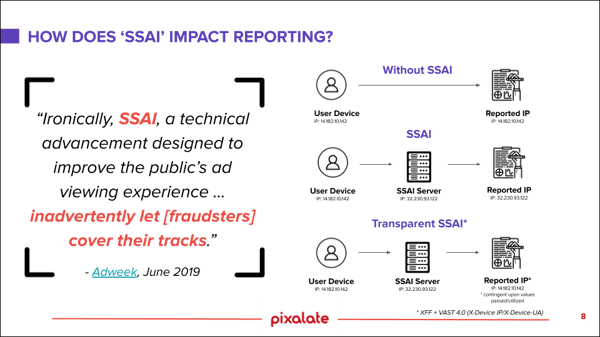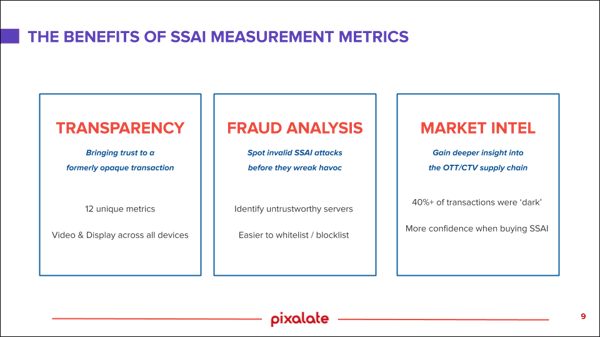Pixalate recently received Accreditations for multiple metrics from the Media Rating Council (MRC) across over-the-top (OTT) / Connected TV (CTV) environments, including 12 Server-Side-Ad-Insertion (SSAI) Measurement Metrics.
SSAI, which Pixalate considers one of the largest risk factors to OTT/CTV advertising, remains a poorly understood topic in ad tech, and our SSAI webinar breaks down what it means and what the implications of new MRC accreditations mean for OTT/CTV advertising.
This post serves as an executive summary of the webinar, which was presented by Chris Schwarz, Pixalate’s Product Manager and subject matter expert on industry guidance.
You can find answers to audience questions about SSAI in OTT/CTV advertising here.
Here is a video recording of the full webinar, in case you missed it:
SSAI is a method of ad delivery in which ad content and video content are "stitched" together and delivered in union via a separate server (i.e. a proxy server, typically operating within data centers).
According to Pixalate's data, in Q1 2020, 40% of all programmatic OTT/CTV is delivered via SSAI. Of that 40%, over one-in-four (28%) of transactions are invalid traffic (IVT), according to Pixalate's measurement.
SSAI is used to create a more seamless user experience when watching internet-enabled TV with ad breaks. It can also make it more difficult for viewers to employ ad blockers.

When SSAI is used, it is difficult to determine if the measurement event itself is being fired from the server level or the client level, according to Schwarz.
When the measurement event occurs at the client level, advertisers are given significantly more insight into the ad being delivered. However, per Schwarz, if it’s measured and recorded from the server-side, insights are limited.
When SSAI is used, its associated IP addresses are anticipated to change quite often. However, not changing frequently enough — or cycling IP address ranges across SSAI integrations too frequently — can lead to exploitation by fraudsters.
Adweek wrote:
“…ironically, SSAI, a technical advancement designed to improve the public’s ad viewing experience … inadvertently let [fraudsters] cover their tracks.”
As Schwarz explained in the webinar, because SSAI transactions proved minimal insight into the end user device, advertisers are swimming in murky water to begin with.
Various frameworks from industry bodies, such as the IAB Tech Lab’s VAST Framework, particularly VAST 4.1+ (VAST 4.2 - June 2019), allow for header values to be passed as part of an SSAI transaction. This means that the proxy server can pass off information about the end user’s device.
However, per Schwarz, “all header values can be entirely falsified,” which makes it easy for fraudsters to hide behind proxy servers under the guise of SSAI.
“Premium brands are often targeted by fraudsters, especially in these very high CPM environments because there is so much money to be made, and one of the ways they are doing it is through the exploitation of SSAI,” said Schwarz.

Pixalate, which now has 12 SSAI measurement metrics accredited by the MRC, is able to dig deeper into SSAI transactions.
Schwarz said one of the key benefits to SSAI measurement is that Pixalate can now evaluate both individual IP addresses as well as the overall reputation of the proxy responsible. There’s no longer a need to go “all-in” (whitelist) or “all-out” (blocklist) on proxy servers.
What are Pixalate's new MRC accreditations for SSAI and OTT/CTV?
You can learn about Pixalate’s latest MRC accreditations here. Here is a summary of Pixalate’s current OTT/CTV MRC accreditations:
Want to learn more about SSAI and ad fraud in OTT/CTV?
Want to learn more about Pixalate’s products and services? Schedule a demo with Pixalate today!
MRC Accreditation (Pixalate 2020 Resources)
Server-Side-Ad-Insertion (SSAI) (Pixalate 2020 Resources)
Disclaimer
Although grounded in Pixalate’s proprietary technology and analytics (which Pixalate evaluates and updates continuously), discussions regarding, among other topics, invalid traffic (IVT) levels by device and ad type, and sophisticated invalid traffic (SIVT) detection in the context of purported server-side ad insertion (SSAI) for OTT/CTV, as set forth in this blog post, represent Pixalate’s opinions (i.e., they are neither facts nor guarantees). Such Pixalate IVT opinions are derived from Pixalate datasets, which consist predominantly of open auction programmatic traffic sources.
We use the term “'Fraud' in this document similarly to how the MRC has used it, in that it “is not intended to represent fraud as defined in various laws, statutes and ordinances or as conventionally used in U.S. Court or other legal proceedings, but rather a custom definition strictly for advertising measurement purposes;” and also per the MRC, “'Invalid Traffic' is defined generally as traffic that does not meet certain ad serving quality or completeness criteria, or otherwise does not represent legitimate ad traffic that should be included in measurement counts. Among the reasons why ad traffic may be deemed invalid is it is a result of non-human traffic (spiders, bots, etc.), or activity designed to produce fraudulent traffic.”
*By entering your email address and clicking Subscribe, you are agreeing to our Terms of Use and Privacy Policy.
These Stories on CTV
*By entering your email address and clicking Subscribe, you are agreeing to our Terms of Use and Privacy Policy.

Disclaimer: The content of this page reflects Pixalate’s opinions with respect to the factors that Pixalate believes can be useful to the digital media industry. Any proprietary data shared is grounded in Pixalate’s proprietary technology and analytics, which Pixalate is continuously evaluating and updating. Any references to outside sources should not be construed as endorsements. Pixalate’s opinions are just that - opinion, not facts or guarantees.
Per the MRC, “'Fraud' is not intended to represent fraud as defined in various laws, statutes and ordinances or as conventionally used in U.S. Court or other legal proceedings, but rather a custom definition strictly for advertising measurement purposes. Also per the MRC, “‘Invalid Traffic’ is defined generally as traffic that does not meet certain ad serving quality or completeness criteria, or otherwise does not represent legitimate ad traffic that should be included in measurement counts. Among the reasons why ad traffic may be deemed invalid is it is a result of non-human traffic (spiders, bots, etc.), or activity designed to produce fraudulent traffic.”

